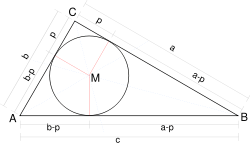Gromov product
In mathematics, the Gromov product is a concept in the theory of metric spaces named after the mathematician Mikhail Gromov. The Gromov product can also be used to define δ-hyperbolic metric spaces in the sense of Gromov.
Definition
Let (X, d) be a metric space and let x, y, z ∈ X. Then the Gromov product of y and z at x, denoted (y, z)x, is defined by
Motivation

Given three points x, y, z in the metric space X, by the triangle inequality there exist non-negative numbers a, b, c such that . Then the Gromov products are . In the case that the points x, y, z are the outer nodes of a tripod then these Gromov products are the lengths of the edges.
In the hyperbolic, spherical or euclidean plane, the Gromov product (A, B)C equals the distance p between C and the point where the incircle of the geodesic triangle ABC touches the edge CB or CA. Indeed from the diagram c = (a – p) + (b – p), so that p = (a + b – c)/2 = (A,B)C. Thus for any metric space, a geometric interpretation of (A, B)C is obtained by isometrically embedding (A, B, C) into the euclidean plane[1].
Properties
- The Gromov product is symmetric: (y, z)x = (z, y)x.
- The Gromov product degenerates at the endpoints: (y, z)y = (y, z)z = 0.
- For any points p, q, x, y and z,
Points at infinity
Consider hyperbolic space Hn. Fix a base point p and let and be two distinct points at infinity. Then the limit
exists and is finite, and therefore can be considered as a generalized Gromov product. It is actually given by the formula
δ-hyperbolic spaces and divergence of geodesics
The Gromov product can be used to define δ-hyperbolic spaces in the sense of Gromov.: (X, d) is said to be δ-hyperbolic if, for all p, x, y and z in X,
In this case. Gromov product measures how long geodesics remain close together. Namely, if x, y and z are three points of a δ-hyperbolic metric space then the initial segments of length (y, z)x of geodesics from x to y and x to z are no further than 2δ apart (in the sense of the Hausdorff distance between closed sets).
Notes
- Väisälä, Jussi (2005-09-15). "Gromov hyperbolic spaces". Expositiones Mathematicae. 23 (3): 187–231. doi:10.1016/j.exmath.2005.01.010. ISSN 0723-0869.
- Roe, John (2003). Lectures on coarse geometry. Providence: American Mathematical Society. p. 114. ISBN 0-8218-3332-4.
References
- Coornaert, M.; Delzant, T.; Papadopoulos, A. (1990), Géométrie et théorie des groupes. Les groupes hyperboliques de Gromov, Lecture Notes in Mathematics (in French), 1441, Springer-Verlag, ISBN 3-540-52977-2
- Kapovich, Ilya; Benakli, Nadia (2002). "Boundaries of hyperbolic groups". Combinatorial and geometric group theory (New York, 2000/Hoboken, NJ, 2001). Contemp. Math. 296. Providence, RI: Amer. Math. Soc. pp. 39–93. MR 1921706.
- Väisälä, Jussi (2005). "Gromov hyperbolic spaces". Expositiones Mathematicae. 23 (3): 187–231. doi:10.1016/j.exmath.2005.01.010.